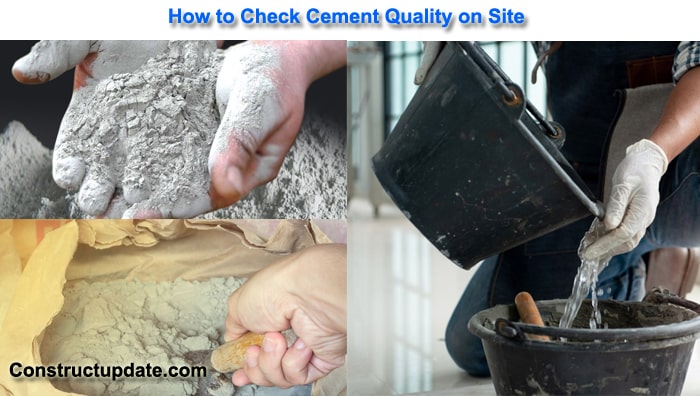How to Test Cement Quality | Cement Quality Check at Construction Site
Cement is the most commonly used building material. It functions as a binder in concrete, binding aggregate and sand together. There are numerous hypotheses on how to test the quality of cement in the lab, but most of them necessitate the use of large apparatus.
It is difficult to examine all of the qualities of cement on the job site, but there are several preliminary field tests that can give us an idea of the cement’s quality.
The tests listed below are basic tests that may be performed on-site to determine the quality of cement without the use of any special equipment. These first testing include determining the characteristics of cement that influence the strength and quality of the cement.

The tests listed below are used to check the quality of cement on-site:
01. Color Test of Cement
The colour of ordinary Portland cement is usually dark greenish-grey. As a result, inspect the colour of cement before using it on a construction site. The light grey colour of cement may suggest that it is older or that it is deteriorating due to moisture.
02. Presence of Lumps
Lumpiness in cement suggests that it has been exposed to moisture. As a result, cement bags with small, hard lumps should be rejected. The lumps indicate that the cement has hardened.
03. Checking the Manufacturing Date of Cement
The cement bag should be verified for the manufacturing date. As previously said, new cement will have good quality, but as time passes, the quality of the cement will deteriorate, as will its efficiency. As a general rule, before using cement on a construction site, check the age of the cement by looking at the printed manufacturing date on the cement bag.
04. Float Test
Take a handful of cement and drop it into water; good grade cement should sink rather than float.
05. Temperature Test
While in the bag, cement has a propensity to stay chilly. This implies it feels cool when you touch it. As a result, place your palm into the cement bag to verify the temperature. If the interior temperature of the cement is less than 60°F, the cement is of good quality.
06. Cement Strength Test
Make a cement block and let it cure for seven days. Then, with a span of 150mm, place the specimen on a support. Then, with a weight of roughly 34 kilogrammes, load the cement sample. The cement block should not show any signs of failure. The cement block should be 25mm in width, 25mm in height, and 200mm in length.
07. Cement Smell Test
Smell a pinch of cement; if it gives off an earthy odour, it means the cement includes a lot of pulverised silt and clay as an adulterant.
08. Test to Check Addition of Another Substance
Cement is a powdery substance. As a result, when you rub the cement between your fingertips, it feels smooth. This type of cement should be deemed good. If you feel gritty or rough, it signifies that additional substances, such as silt, are present in the cement, which could reduce its strength.
09. Cement Setting Test
Take a specific amount of cement and combine it with water. Then, pour the mixture onto a glass plate and immerse it in water for 24 hours. The cement paste should harden rather than crack.
10. Strength test
Make a cement block with dimensions of 25 mm x 25 mm and a length of 200 mm. Soak the block in water for seven days. Place the immersed block on 15000 mm apart supports, then load it with 340 N. The block should not exhibit any signs of failure if it is composed of good cement.





